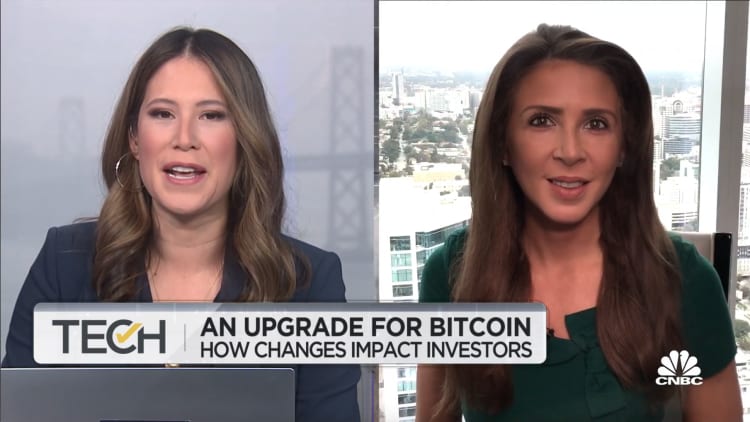Bitcoin’s biggest upgrade in four years just happened – here’s what changes

watch now
The first bitcoin upgrade in four years has just gone live. It is a rare moment of consensus among stakeholders, and it’s a big deal for the world’s most popular cryptocurrency.
The Taproot update means greater transaction privacy and efficiency – and crucially, it will unlock the potential for smart contracts, which can be used to eliminate middlemen from transactions.
Mục lục bài viết
related investing news

Bank of America doubles down on its buy rating for this under-the-radar A.I. play
“Taproot matters, because it opens a breadth of opportunity for entrepreneurs interested in expanding bitcoin’s utility,” said Alyse Killeen, founder and managing partner of bitcoin-focused venture firm Stillmark.
Unlike bitcoin’s 2017 upgrade – referred to as the “last civil war” because of the contentious ideological divide separating adherents – Taproot has near universal support, in part because these changes involve fairly incremental improvements to the code.
What’s changing
A big part of bitcoin’s makeover has to do with digital signatures, which are like the fingerprint an individual leaves on every transaction.
Right now, the cryptocurrency uses something called the “Elliptic Curve Digital Signature Algorithm,” which creates a signature from the private key that controls a bitcoin wallet, and ensures that bitcoin can only be spent by the rightful owner.
Taproot will add something known as Schnorr signatures, which essentially makes multi-signature transactions unreadable, according to bitcoin miner Alejandro De La Torre.
It won’t translate to greater anonymity for your individual bitcoin address on the public blockchain, but it will make simple transactions indistinguishable from those that are more complex and comprised of multiple signatures.
In practice, that means greater privacy, because your keys won’t have as much exposure on the chain. “You can kind of hide who you are a little bit better, which is good,” said bitcoin mining engineer Brandon Arvanaghi, who now runs Meow, a company that enables corporate treasury participation in crypto markets.
Smart contracts
These souped-up signatures are also a game changer for smart contracts, which are self-executing agreements that live on the blockchain. Smart contracts could theoretically be used for practically any kind of transaction, from paying your rent each month, to registering your vehicle.
Taproot makes smart contracts cheaper and smaller, in terms of the space they take up on the blockchain. Killeen says that this enhanced functionality and efficiency presents “mind blowing potential.”
Currently, smart contracts can be created both on bitcoin’s core protocol layer and on the Lightning Network, a payments platform built on bitcoin, which enables instant transactions. Smart contracts executed on the Lightning Network typically lead to faster and less costly transactions.
“Lightning transactions can be fractions of a penny…while a bitcoin transaction at the core protocol layer can be much more expensive than that,” explained Killeen.
Developers had already begun to build on Lightning in anticipation of the upgrade, which will allow for highly specific contracts.
“The most important thing for Taproot is…smart contracts,” said Fred Thiel, CEO of cryptocurrency mining specialist Marathon Digital Holdings. “It’s already the primary driver of innovation on the ethereum network. Smart contracts essentially give you the opportunity to really build applications and businesses on the blockchain.”
As more programmers build smart contracts on top of bitcoin’s blockchain, bitcoin could become more of a player in the world of DeFi, or decentralized finance, a term used to describe financial applications designed to cut out the middleman.
Today, ethereum dominates as the blockchain of choice for these apps, also referred to as “dApps.”
Why the wait
Although the bitcoin community agreed to lock in the upgrade in June, the rollout itself didn’t happen until November. The couple month delay was designed to give enough time for testing and reducing the likelihood of something going wrong during the upgrade.
“Upgrades allow the – extremely remote – possibility of a bug entering the system, which would destroy confidence in the whole cryptocurrency system, effectively wiping it out – a ‘self-inflicted wound’ if you like,” said Jason Deane, an analyst at Quantum Economics.
Deane says this is why upgrade processes are so carefully tested, retested, and vetted over very long periods of time.
Many users in the community also remember the disastrous migration of 2013, when an upgrade gone wrong resulted in bitcoin temporarily splitting in half.
“You don’t want different clients or miners in the protocol out of sync. That’s how catastrophic stuff happens,” Nic Carter, founding partner at Castle Island Ventures, told CNBC. “Because we don’t want a repeat of 2013, we have these extremely long lead times.”

watch now












